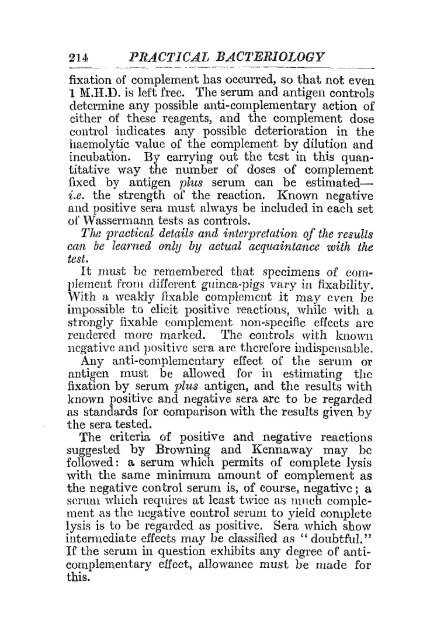AGf~ICULTURAL RESEARCH, PUSA.
AGf~ICULTURAL RESEARCH, PUSA.
AGf~ICULTURAL RESEARCH, PUSA.
You also want an ePaper? Increase the reach of your titles
YUMPU automatically turns print PDFs into web optimized ePapers that Google loves.
214 PRACTICAL BAC1'ERIOLOGY<br />
fixation of complement has occurred, so that not even<br />
1 M.H.D. is left free. The serum and antigen controls<br />
determine any possible anti-complementary action of<br />
either of these reagents, and the complement dose<br />
control indicates any possible deterioration in the<br />
haemolytic value of the complement by dilution and<br />
incubation. By carrying out the test in this quantitative<br />
way the number of doses of complement<br />
fixed by antigen plus serum can be estimatedi.e.<br />
the strength of the reaction. Known negative<br />
and positive sera must always be included in each set<br />
of "Vassermann tests as controls.<br />
The pract'ical details and interpretation of the results<br />
can be lew'ned only by actual acquaintance with the<br />
test.<br />
It must be remembered that specimens of complement<br />
from different guinea-pigs vary in fixability.<br />
With a weakly fixable complement it may even be<br />
impossible to elicit posit'ive reactions, while with a<br />
strongly fixable complement non-specific effects arc<br />
rendered morc marked. The controls with known<br />
negative and positive sera are therefore indispensable.<br />
Any anti-complementary effect of the serum or<br />
antigen must be allowed for in estimating the<br />
fixation by serum plus antigen, and the results with<br />
known positive and negative sera are to be regarded<br />
as standards for comparison with the results given by<br />
the sera tested.<br />
The criteria of positive and negative reactions<br />
suggested by Browning and Kennaway may be<br />
followed: a serum which permits of complete lysis<br />
with the same minimum amount of complement as<br />
the negative control serUlll is, of course, negative; a<br />
SCl'11Ill whieh recpdres at least twice Hf> mnch complement<br />
as the negative control serum to yield complete<br />
lysis is to be regarded as positive. Sera which show<br />
intermediate effects may be classified as "doubtful."<br />
If the serum in question exhibits any degree of anticomplementary<br />
effect, allowance must be made for<br />
this.

















